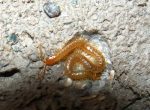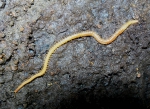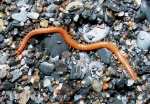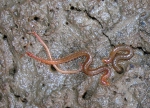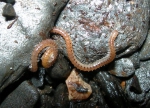
| Introduction | | Pauropoda | | Symphyla | | Chilopoda | | Diplopoda | | Literature | | Images | | Log in |
Myriapods of the sea shoreAs with other terrestrial arthropod groups such as spiders, scorpions, pseudoscorpions and insects, a variety of species from the four multi-legged arthropod classes (Pauropoda, Symphyla, Diplopoda and Chilopoda) collectively known as myriapods have been described from seashore sites at different times. However confusion can occur over both the definition of “littoral” and of the halophilic or otherwise status of particular examples. A term such as “littoral Mediterranean” might refer to shoreline species or to species found in ecosystems along the coast and maybe up to a considerable distance/height above it. Here we use the term to cover species found around high-water mark and below, maybe even down to mid-tide level.
It is often difficult to be clear about the precise status of a species on the shore is as to whether myriapods found in or close to the littoral zone are obligate halophiles, species that are typically terrestrial but also occur on the shore or just chance occurrences. Filippo Silvestri (1903) referred to myriapodi halofili genuini i.e. confined to such habitats (obligate halophiles), myriapodi halofili indifferenti i.e. occurring in both terrestrial and littoral habitats (facultative halophiles) or myriapodi halofili accidentali i.e. chance occurrences (accidental halophiles). Such a situation may well be true of all “terrestrial” groups in which some species have invaded the littoral zone. The geophilomorph centipede Hydroschendyla submarina, for instance, has only ever recorded from seashores in northern Europe, the Mediterranean and Bermuda and is clearly genuini whilst the widespread Pachymerium ferrugineum is clearly indifferenti in much of its range. The situation is made more complex by species such as Schendyla peyerimhoffi which appear to be genuini in one country but occur inland in another. In many cases, where species are described from a single littoral site clarity of status is impossible to clarify and these lists may include some species which may later be considered accidentali. Myriapods have been found in a diversity of sites on the upper shore and around high tide level including under/in strand-line debris, in shingle, under stones on mud and, possibly the most difficult to sample, in rock crevices. Thalassisobates littoralis has been found in pitfall and shingle traps and other species have been extracted from debris using Tulgren (Berlese) funnels. Historical backgroundOther than the comment about Scutigera coleoptrata by Pallas (1772) (see below), the first record of a halophilic myriapod seems to be that of Leach (1817), describing Strigamia maritima (as it is now known) as “Habitat in Britannia inter scopulos ad littoral maris vulgatissime”. Parfitt (1866) reported the rediscovery of the species at Plymouth, England; other early records are from Sweden, Helgoland, Norway, Denmark and Northern France (Hennings, 1903) and from Ireland (Pocock 1893). Grube (1872) described a second littoral species, Hydroschendyla submarina from St. Malo on the French Channel coast, Thompson (1889) reported this from Jersey and Pocock (1889) drew attention to the existence of specimens from Cornwall in the Natural History Museum, London that had been collected in 1868 but not recognised. The first Mediterranean record of this species seems to be that of Silvestri (1903) from Portici, Italy. At the same time, he also recorded the first halophilic diplopod, Thalassisobates littoralis, from the Italian Mediterranean and listed as halophiles the centipedes Pachymerium ferrugineum, Tuoba poseidonis and Henia bicarinata and the millipede Polyxenus lapidicola. By this time, Porat (1894) had described what appears to be the first non-European halophile centipede Tretecthus uliginosus from Cameroun. Subsequently more apparently littoral centipedes have been described so that there are now in excess of 40 listed but the number of littoral millipedes remains small (Barber, 2009). R.S.Bagnall (1911, 1912, 1913) reported symphylids from British shores and later (Bagnall, 1935a, b) also pauropods whilst P.A.Remy (1954) added further pauropod species from the Mediterranean. Scheller & Stoev (2000) and Roth & Brown (in Cheng, 1976) named Symphyla from the Black Sea coast and California respectively. CitationUsage of data from the World Database of Littoral Myriapoda in scientific publications should be acknowledged by citing as follows:
Individual pages are individually authored and dated. These can be cited separately: the proper citation is provided at the bottom of each page. ContactRequests for additional information on littoral myriapods of any of the four classes and/or specimens of seashore myriapods, especially millipedes and geophilomorph centipedes from all parts of the world with appropriate data are very much welcome. Please contact: |
